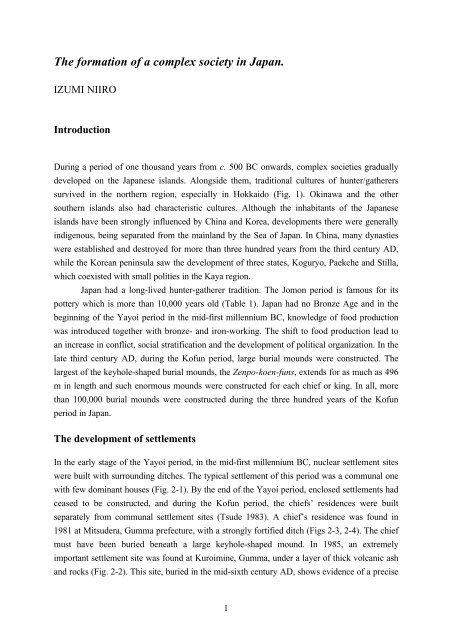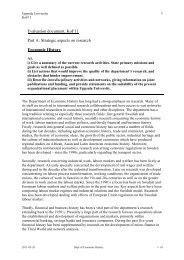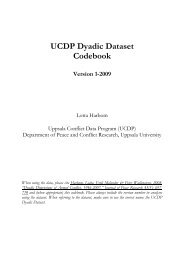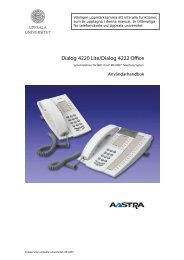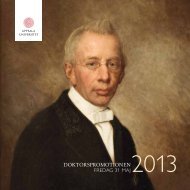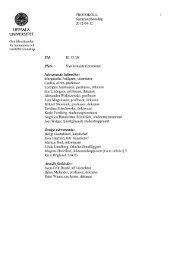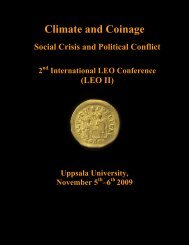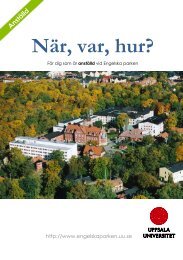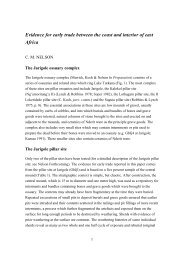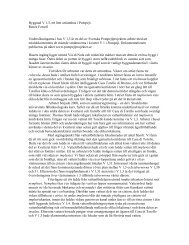The formation of a complex society in Japan.
The formation of a complex society in Japan.
The formation of a complex society in Japan.
You also want an ePaper? Increase the reach of your titles
YUMPU automatically turns print PDFs into web optimized ePapers that Google loves.
<strong>The</strong> <strong>formation</strong> <strong>of</strong> a <strong>complex</strong> <strong>society</strong> <strong>in</strong> <strong>Japan</strong>.IZUMI NIIROIntroductionDur<strong>in</strong>g a period <strong>of</strong> one thousand years from c. 500 BC onwards, <strong>complex</strong> societies graduallydeveloped on the <strong>Japan</strong>ese islands. Alongside them, traditional cultures <strong>of</strong> hunter/gathererssurvived <strong>in</strong> the northern region, especially <strong>in</strong> Hokkaido (Fig. 1). Ok<strong>in</strong>awa and the othersouthern islands also had characteristic cultures. Although the <strong>in</strong>habitants <strong>of</strong> the <strong>Japan</strong>eseislands have been strongly <strong>in</strong>fluenced by Ch<strong>in</strong>a and Korea, developments there were generally<strong>in</strong>digenous, be<strong>in</strong>g separated from the ma<strong>in</strong>land by the Sea <strong>of</strong> <strong>Japan</strong>. In Ch<strong>in</strong>a, many dynastieswere established and destroyed for more than three hundred years from the third century AD,while the Korean pen<strong>in</strong>sula saw the development <strong>of</strong> three states, Koguryo, Paekche and Stilla,which coexisted with small polities <strong>in</strong> the Kaya region.<strong>Japan</strong> had a long-lived hunter-gatherer tradition. <strong>The</strong> Jomon period is famous for itspottery which is more than 10,000 years old (Table 1). <strong>Japan</strong> had no Bronze Age and <strong>in</strong> thebeg<strong>in</strong>n<strong>in</strong>g <strong>of</strong> the Yayoi period <strong>in</strong> the mid-first millennium BC, knowledge <strong>of</strong> food productionwas <strong>in</strong>troduced together with bronze- and iron-work<strong>in</strong>g. <strong>The</strong> shift to food production lead toan <strong>in</strong>crease <strong>in</strong> conflict, social stratification and the development <strong>of</strong> political organization. In thelate third century AD, dur<strong>in</strong>g the K<strong>of</strong>un period, large burial mounds were constructed. <strong>The</strong>largest <strong>of</strong> the keyhole-shaped burial mounds, the Zenpo-koen-funs, extends for as much as 496m <strong>in</strong> length and such enormous mounds were constructed for each chief or k<strong>in</strong>g. In all, morethan 100,000 burial mounds were constructed dur<strong>in</strong>g the three hundred years <strong>of</strong> the K<strong>of</strong>unperiod <strong>in</strong> <strong>Japan</strong>.<strong>The</strong> development <strong>of</strong> settlementsIn the early stage <strong>of</strong> the Yayoi period, <strong>in</strong> the mid-first millennium BC, nuclear settlement siteswere built with surround<strong>in</strong>g ditches. <strong>The</strong> typical settlement <strong>of</strong> this period was a communal onewith few dom<strong>in</strong>ant houses (Fig. 2-1). By the end <strong>of</strong> the Yayoi period, enclosed settlements hadceased to be constructed, and dur<strong>in</strong>g the K<strong>of</strong>un period, the chiefs’ residences were builtseparately from communal settlement sites (Tsude 1983). A chief’s residence was found <strong>in</strong>1981 at Mitsudera, Gumma prefecture, with a strongly fortified ditch (Figs 2-3, 2-4). <strong>The</strong> chiefmust have been buried beneath a large keyhole-shaped mound. In 1985, an extremelyimportant settlement site was found at Kuroim<strong>in</strong>e, Gumma, under a layer <strong>of</strong> thick volcanic ashand rocks (Fig. 2-2). This site, buried <strong>in</strong> the mid-sixth century AD, shows evidence <strong>of</strong> a precise1
layout <strong>of</strong> houses and farms. Later <strong>in</strong> the seventh century AD, capital cities developed that were<strong>in</strong>tentionally planned by political authorities, and not the direct outcome <strong>of</strong> urbanization.<strong>The</strong> process <strong>of</strong> urbanization <strong>in</strong> <strong>Japan</strong> has two characteristics: (1) <strong>The</strong> chiefs, ow<strong>in</strong>g totheir strong power and <strong>in</strong>dependent status from the communities, prevented the freedevelopment <strong>of</strong> urban societies. (2) <strong>The</strong> resources put <strong>in</strong>to production and reproduction werelimited, as a large part <strong>of</strong> the wealth was consumed <strong>in</strong> construct<strong>in</strong>g burial mounds. <strong>The</strong>se twocharacteristics show the weakness <strong>in</strong> the autonomous development <strong>of</strong> urban societies <strong>in</strong> <strong>Japan</strong>.Capital cities <strong>of</strong> the next stage therefore <strong>in</strong>dicate their political rather than economic nature.<strong>The</strong> hierarchy <strong>of</strong> power<strong>The</strong> word ‘K<strong>of</strong>un’ means old mound. In the three hundred years <strong>of</strong> the K<strong>of</strong>un period,thousands <strong>of</strong> Zenpo-koen-funs, keyhole-shaped burial mounds, from 20 m to 486 m long, wereconstructed. <strong>The</strong> total number <strong>of</strong> K<strong>of</strong>uns, <strong>in</strong>clud<strong>in</strong>g small round barrows constitut<strong>in</strong>gcemeteries, is more than 100,000. <strong>The</strong> volume <strong>of</strong> the biggest mound is more than 1,000,000m 3 . Usually the bodies were buried <strong>in</strong> stone chambers with many prestige items, e.g. bronzemirrors, weapons and jewellery. <strong>The</strong> size <strong>of</strong> each burial mound reflects the volume <strong>of</strong> humanpower the dead person could assemble and consequently the dead person’s degree <strong>of</strong> authority.Figure 3 shows the size <strong>of</strong> the largest Zenpo-koen-fun <strong>in</strong> each old prov<strong>in</strong>ce, and many <strong>of</strong> themwere constructed <strong>in</strong> the fifth century AD. <strong>The</strong> map <strong>in</strong>dicates a developed stage <strong>of</strong> socialstratification and the same hierarchy is shown <strong>in</strong> the smaller area <strong>of</strong> the Okayama region.However, the evidence from the settlements does not clearly support a hierarchy as <strong>in</strong>dicatedby the size <strong>of</strong> burial mounds.<strong>The</strong> system <strong>of</strong> the JieAt the base <strong>of</strong> this hierarchical organization lies a Ch<strong>in</strong>ese system <strong>of</strong> dom<strong>in</strong>ation (Niiro 1989).In ancient Ch<strong>in</strong>a, jo<strong>in</strong>ts <strong>of</strong> bamboos (Jie <strong>in</strong> Ch<strong>in</strong>ese) were used as tests <strong>of</strong> reliability (Fig. 4).<strong>The</strong> m<strong>in</strong>ute form <strong>of</strong> each jo<strong>in</strong>t is so complicated that if split <strong>in</strong>to two or more pieces no piecefrom another jo<strong>in</strong>t fits exactly <strong>in</strong>to the broken end. Bamboos were used by the emperors tocontrol the reliability <strong>of</strong> their delegates. <strong>The</strong>y split a bamboo <strong>in</strong>to two or more pieces and keptone for themselves and let the other pieces to their delegates who could use them to identifyeach other. If the pieces fit together, they could be sure that the other delegate was the rightman. This Jie system turned later <strong>in</strong>to a symbol <strong>of</strong> authority <strong>of</strong> the emperors. K<strong>in</strong>gs <strong>of</strong> <strong>Japan</strong>,Korea and other regions were given the title <strong>of</strong> ‘the Jie Holder’ from Ch<strong>in</strong>ese emperors. <strong>The</strong>form <strong>of</strong> the Jie was depicted <strong>in</strong> Ch<strong>in</strong>ese documents. It was also pa<strong>in</strong>ted on the wall <strong>of</strong> a burialchamber <strong>in</strong> Korea, and there is an <strong>in</strong>scription ‘the Jie holder’ on a wall <strong>in</strong> the same chamber.Jie battle-axes <strong>in</strong> ancient Ch<strong>in</strong>a symbolized the military authority <strong>of</strong> the emperors. Some time2
later, battle-axes gave place to swords and a custom grant<strong>in</strong>g swords to subord<strong>in</strong>ate k<strong>in</strong>gs andchiefs played an important part <strong>in</strong> the system <strong>of</strong> dom<strong>in</strong>ation.Triangular rimmed bronze mirrors with Jie motifs have been found <strong>in</strong> burial mounds <strong>of</strong>the late third century and the early fourth century AD <strong>in</strong> <strong>Japan</strong>. Several mirrors were cast fromeach mould (Kobayashi 1976, pp. 303–77; Fig. 5). <strong>The</strong> network <strong>of</strong> chiefs l<strong>in</strong>ked together bythe system <strong>of</strong> the Jie is the characteristic Eastern way to organize political relations <strong>in</strong> thecourse <strong>of</strong> <strong>formation</strong> <strong>of</strong> <strong>complex</strong> societies.Agricultural basis<strong>The</strong> relatively rapid development <strong>of</strong> the <strong>complex</strong> <strong>society</strong> <strong>in</strong> <strong>Japan</strong> was partly due to its highagricultural productivity. Before <strong>in</strong>dustrialization, each typical <strong>Japan</strong>ese farmer had very littleland, less than one hectar. However, because <strong>of</strong> its high productivity <strong>of</strong> wet cultivation, such asmall area could support the life <strong>of</strong> a family and produced surplus to pay heavy taxes. <strong>The</strong>rewere no sheep nor much cattle <strong>in</strong> prehistoric <strong>Japan</strong>. Rice fields were cultivated with ma<strong>in</strong>lyhuman power and therefore communal cooperation was essential. Communal control <strong>of</strong>irrigation systems also promoted the cluster<strong>in</strong>g <strong>of</strong> settlements. <strong>The</strong> smallness <strong>of</strong> each landhelped easy access from the clustered settlements. This <strong>in</strong>tensive farm<strong>in</strong>g created a <strong>Japan</strong>eserural landscape completely different from those <strong>in</strong> Europe.<strong>The</strong> population <strong>of</strong> the 8th century <strong>Japan</strong> has been estimated to approximatelyfive million, based on the fragmentary documents <strong>of</strong> the family registration. This figure isremarkable compared to the population <strong>of</strong> about one million <strong>in</strong> eleventh century Brita<strong>in</strong>, basedon the census <strong>of</strong> Domesday Book. <strong>The</strong>re is not such a large difference <strong>in</strong> size <strong>of</strong> land betweenthese countries and, furthermore, <strong>in</strong> <strong>Japan</strong>, a relatively small part <strong>of</strong> the land was cultivated.This <strong>in</strong>tensive agricultural system on the one hand brought the rapid development <strong>of</strong>ceremonial monuments and political hierarchy. However it also prevented the autonomousdevelopment <strong>of</strong> economic systems. <strong>The</strong> <strong>in</strong>dependence <strong>of</strong> <strong>in</strong>dividual families from thecommunity was prevented and the status <strong>of</strong> specialists was relatively low. <strong>The</strong> wealth from thehigh productivity was ma<strong>in</strong>ly used for communal or public purposes such as the construction <strong>of</strong>huge burial mounds. <strong>The</strong> development <strong>of</strong> merchant and commercial economy was thereforevery late and the <strong>in</strong>troduction <strong>of</strong> co<strong>in</strong>age was as late as the seventh century, although co<strong>in</strong>s assuch had been <strong>in</strong>troduced more than half a century earlier from Ch<strong>in</strong>a. <strong>The</strong> political regimebased on this system has been refered to as the 'Asiatic' despotism.Recent theoretical frameworkAfter the World War II, the most urgent theoretical responsibility for <strong>Japan</strong>ese archaeologistswas to criticize and overcome the traditional historical framework based on nationalism andthe Emperor centralism. <strong>The</strong>re were two major themes. <strong>The</strong> first was to criticize the Yamato3
or K<strong>in</strong>ai centralism, Yamato be<strong>in</strong>g the region said to be the birthplace <strong>of</strong> the Emperor's family.<strong>The</strong> second theme was to reexam<strong>in</strong>e the relationship with Korean cultures. Traditionally,ancient <strong>Japan</strong> has been thought to have a very simple political hierarchy, with an emperor atthe top <strong>of</strong> the hierarchy and all the regional societies subord<strong>in</strong>ated to the emperor. This regimewas believed to have cont<strong>in</strong>ued without any serious <strong>in</strong>terruption. However, the theoretical andpractical re-exam<strong>in</strong>ation has shown that the central authority was not so simple but rather analliance <strong>of</strong> plural powers <strong>in</strong>clud<strong>in</strong>g some changes <strong>of</strong> political regimes, or dynasties. <strong>The</strong> role<strong>of</strong> the powers <strong>of</strong> the peripheral regions was also re-exam<strong>in</strong>ed and the relative <strong>in</strong>dependence <strong>of</strong>the different regional powers has been stressed. <strong>The</strong>se tendencies have encouraged settlementarchaeology to identify the differences with<strong>in</strong> the central regions, the characteristics <strong>of</strong> eachregion and the <strong>complex</strong> relationship between the central regions and the peripheral authorities.Dur<strong>in</strong>g the imperial colonization <strong>of</strong> Korea by <strong>Japan</strong> after 1911 historical andarchaeological evidence was utilized to authorize the dom<strong>in</strong>ation. Mimana <strong>of</strong> the southern part<strong>of</strong> Korea was clamed to have been the territory <strong>of</strong> <strong>Japan</strong> and both people were said to have acommon ancestry. This framework was strongly criticized after the <strong>in</strong>dependence <strong>of</strong> Korea andthe theory <strong>of</strong> the dom<strong>in</strong>ation <strong>of</strong> Mimana by ancient <strong>Japan</strong> was thoroughly denied. SomeKorean and <strong>Japan</strong>ese archaeologists have also tried to identify Korean factors <strong>in</strong>archaeological materials <strong>in</strong> <strong>Japan</strong>. Although some difference <strong>in</strong> nuance can still be seen, thereare no serious conflicts between the archaeologists <strong>of</strong> the two countries. <strong>Japan</strong>esearchaeologists have recently tried to f<strong>in</strong>d direct ties between Korean and <strong>Japan</strong>ese regionalpowers which did not <strong>in</strong>volve the <strong>in</strong>terference <strong>in</strong> <strong>society</strong> <strong>of</strong> a central authority.In this context <strong>of</strong> archaeological research, there has been a tendency to see the K<strong>of</strong>unperiod as occurr<strong>in</strong>g prior to the state <strong>formation</strong>. This was <strong>in</strong> a sense a reaction to thetraditional image <strong>of</strong> the emperor-dom<strong>in</strong>ated state. However, recently some archaeologists suchas Hiroshi Tsude have po<strong>in</strong>ted out that the K<strong>of</strong>un period <strong>society</strong> was more <strong>complex</strong> and moredeveloped, and should be considered as an early state. Some historians have criticized thisop<strong>in</strong>ion and controversies cont<strong>in</strong>ue.ConclusionIn the process <strong>of</strong> urbanization <strong>in</strong> <strong>Japan</strong>, the political factor played a more important role thanthe economic one, which may also be the case <strong>in</strong> other regions <strong>in</strong> eastern Asia. <strong>The</strong> strongauthority <strong>of</strong> the chiefs and k<strong>in</strong>gs weakened the autonomous development <strong>of</strong> urban societies.This lead to poverty <strong>in</strong> the settlements, but to richness <strong>of</strong> the burial mounds dur<strong>in</strong>g the K<strong>of</strong>unperiod <strong>in</strong> <strong>Japan</strong>. Two factors should however be taken <strong>in</strong>to account: 1) It might not have beennecessary to live close together <strong>in</strong> this area, due to fewer social conflicts and ample space tobuild houses; 2) <strong>The</strong> build<strong>in</strong>g material <strong>of</strong> the houses seems to bias our impression. A settlementcomposed <strong>of</strong> wooden houses without dist<strong>in</strong>ct fortifications tends to leave fewer archaeologicaltraces than one <strong>of</strong> stone houses.4
ReferencesKobayashi, Y. 1976. K<strong>of</strong>un Bunka Ronko. Tokyo: Heibonsha. In <strong>Japan</strong>eseNiiro, I. 1989. Relations between k<strong>in</strong>gs. In Reconstruct<strong>in</strong>g Ancient History 6, Tsude, H.(ed.), 145–61. Tokyo: Kodansha. In <strong>Japan</strong>eseTsude, H. 1983. <strong>The</strong> appearance and ext<strong>in</strong>ction <strong>of</strong> the settlements with ditches.Quarterly <strong>of</strong> Archaeological Studies 116, 14–32. In <strong>Japan</strong>ese.IllustrationsFigure 1. Map <strong>of</strong> <strong>Japan</strong> and surround<strong>in</strong>g area (fifth century AD).Figure 2. Three typical examples <strong>of</strong> settlement <strong>in</strong> the Yaoi and K<strong>of</strong>un periods.Figure 3. Hierarchy <strong>of</strong> power shown by the size <strong>of</strong> burial mounds, ma<strong>in</strong>ly fifth century AD.(<strong>The</strong> largest mounds <strong>of</strong> each prov<strong>in</strong>ce is shown).Figure 4. <strong>The</strong> development <strong>of</strong> the Jie. A Ch<strong>in</strong>ese system <strong>of</strong> display<strong>in</strong>g credibility.Figure 5. Relations <strong>of</strong> triangular rimed bronze mirrors.Table 1. Chronology <strong>in</strong> <strong>Japan</strong>.5
Figure 1. Map <strong>of</strong> <strong>Japan</strong> and surround<strong>in</strong>g area (fifth century AD).
Figure 2. Three typical examples <strong>of</strong> settlement <strong>in</strong> the Yaoi and K<strong>of</strong>un periods.
Figure 3. Hierarchy <strong>of</strong> power shown by the size <strong>of</strong> burial mounds, ma<strong>in</strong>ly fifth century AD.(<strong>The</strong> largest mounds <strong>of</strong> each prov<strong>in</strong>ce is shown).
Figure 4. <strong>The</strong> development <strong>of</strong> the Jie. A Ch<strong>in</strong>ese system <strong>of</strong> display<strong>in</strong>g credibility.
Figure 5. Relations <strong>of</strong> triangular rimed bronze mirrors.
Table 1. Chronology <strong>in</strong> <strong>Japan</strong>.


